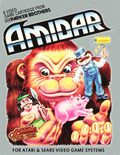
































Amidar

Amidar is an arcade game programmed by Konami and published in 1981 by Stern. Its basic format is similar to that of Pac-Man: the player moves around a fixed rectilinear lattice, attempting to visit each location on the board while avoiding the enemies. When each spot has been visited, the player moves to the next level.
The game and its name have their roots in the Japanese lot drawing game Amidakuji. The bonus level in Amidar is a nearly exact replication of an Amidakuji game and the way the enemies move conform to the Amidakuji rules - this is referred to in the attract sequence as 'Amidar movement'.
As in Pac-Man, the player is opposed by enemies who kill on contact. The enemies gradually increase in number as the player advances from one level to the next, and their speed also increases. On odd-numbered levels, the player controls an ape (in some versions labeled 'Copier'), and must collect coconuts while avoiding headhunters (labeled 'Police' and 'Thief'). On even-numbered levels, the player controls a paint roller (labeled 'Rustler'), and must paint over each spot of the board while avoiding pigs (labeled 'Cattle' and 'Thief'). Each level is followed by a short bonus stage.
Whenever a rectangular portion of the board is cleared (either by collecting all surrounding coconuts, or painting all surrounding edges), the rectangle is colored in, and in the even levels, bonus points are awarded (In odd-numbered levels, the player collects points for each coconut eaten). This leads to some comparisons with the popular and influential Qix, although the similarities between these games are superficial at best. When the player clears all four corners of the board, he is briefly empowered to kill the enemies by touching them (just as when Pac-Man uses a 'power pill'). Enemies killed in this way fall to the bottom of the screen and revitalise themselves after a few moments.
The game controls consist of a joystick and a single button labeled 'Jump,' which can be used up to three times, resetting after a level is cleared or the player loses a life. Unusually, pressing the jump button does not cause the player to jump, but causes all the enemies to jump, enabling the player to walk under them.
A simplified version of Amidar was released in 1982 for the Atari 2600. This was the only official port but as with most arcade games of the time, there were many unofficial clones for home computers including Acornsoft's Crazy Tracer (BBC Micro, Acorn Electron), Microdeal's Cuthbert Goes Walkabout (Dragon 32/64, TRS-80 CoCo, Commodore 64, Atari 8-bit family), Llamasoft's Traxx (Vic-20, ZX Spectrum), Superior Software's Crazy Painter (BBC Micro), Gapper and Rollo And The Brush Bros (DOS), and FunSoft's Time Runner (multiple platforms). A clone of this game was released for the Atari 2600, entitled Spiderdroid.
How to play:
Click on the joystick icon in the Amidar online emulator to see how to control the Amidar game









































Comments